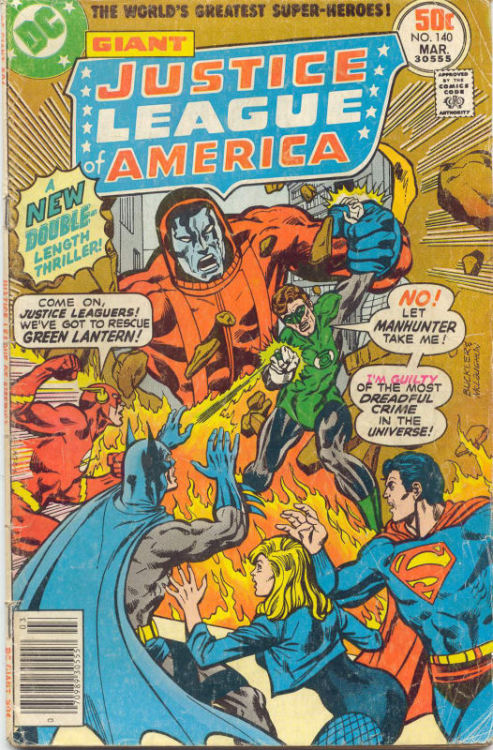#steve englehart
Back to back subscription copies meant that I also got the next issue of JUSTICE LEAGUE OF AMERICA during this period. It was another great issue in the all-new giant format, a big ol’ chunk of new comics every month. Like this month’s FLASH, the cover is by Rich Buckler again inked roughly by Frank Springer. It’s always mystified me a bit the choices DC made on its covers during this period. Somebody over there clearly liked them, but so many of them were poorly or muddily-inked, including the majority of the Ernie Chua/Chan ones. The interiors always looked crisper and cleaner, and I still can’t quite fathom why they thought this approach looked good on the most important page of each issue.
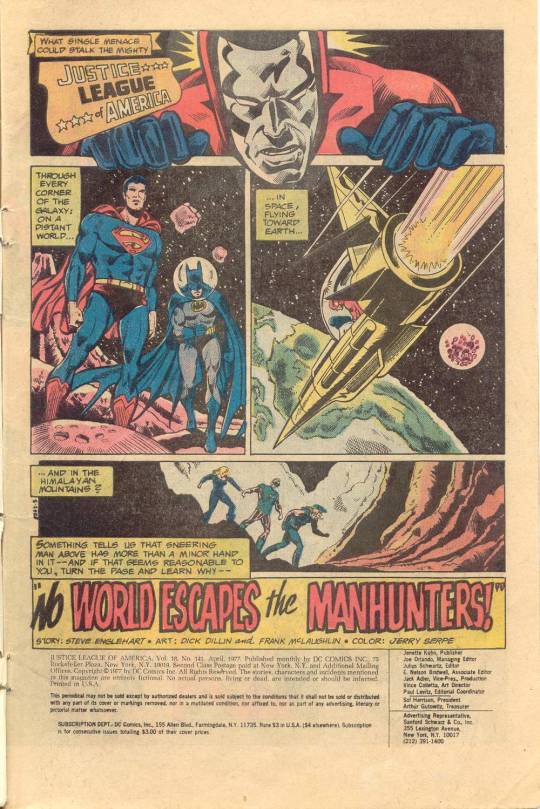
This is the second half of the story begun the previous month involving the intergalactic Manhunters and their attempts to besmirch the reputation of Green Lantern and the Corps he represents. It was also evidence of writer Steve Englehart applying everything that he had learned working on AVENGERS for Marvel to its nearest DC counterpart. That included a Roy Thomas-style fascination with connecting dots of continuity across the line and a greater emphasis on characterization and personal melodrama–which in the case of JLA had pretty much been set at zero or close to zero before this. As a reader, I was uneasy about some of the choices Steve made here, because I was invested in the characters and wanted them to all get along. But it definitely made for much more engaging and satisfying stories, especially when things built to a payoff.
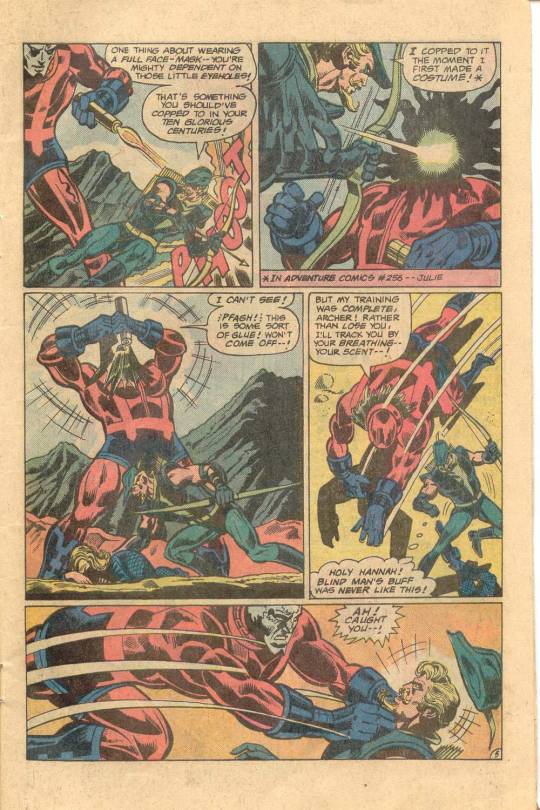
So, picking up from last month, the League has divided its forces in three as they attempt to prove that Green Lantern didn’t accidentally destroy a planet as the Manhunters claim. The hard-traveling trio of Green Lantern, Green Arrow and Black Canary make their escape from the Manhunters’ refuge, only to be tracked by the main Earth Manhunter Mark Shaw, with whom they battle and eventually overcome. Shaw is dedicated to the cause, but it’s the cause of justice–he truly believes that GL is guilty.

Headed back to Earth, the bickering Flash and Wonder Woman are ambushed at the League’s satellite HQ by the Manhunter Grandmaster, who seas them within a force-field that also prevents the satellite from getting any power. With limited time and oxygen left to them, Flash attempts to use the rocket they flew in on to boost his speed so that he can penetrate the force-field, as he and Superman did in tandem in the previous chapter. But he fails in the attempt, and Wonder Woman has to catch his badly-injured body.
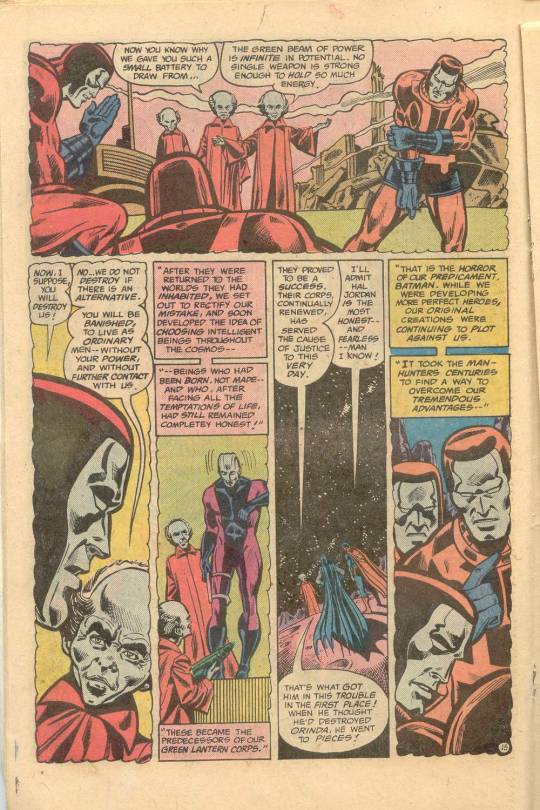
Meanwhile, off in space, after proving that the destroyed planet Orinda is still there, just cloaked from view, the Guardian gives Superman and Batman the lowdown on the Manhunters. When the Guardians took up their task of safeguarding the universe, they had created the original Manhunters, androids, to be their footsoldiers. But the androids eventually rebelled and had to be put down, and were replaced with human agents who became the early Green lantern Corps. But the androids, their ranks bolstered by human recruits, desire revenge on their creators–and so the object of this entire subterfuge has been to discredit and ruin the Guardians and their Green Lantern operatives.

Back at the JLA satellite, Wonder Woman confesses to a barely-breathing Flash that the reason she’s been such a bitch to him recently is down to her own insecurities about her worthiness to have rejoined the League. Then, Englehart uses one of the darkest bits of continuity in League history to get them to freedom, as Wonder Woman releases the Dharlu creature who is kept captive within the satellite in order to allow the place to function. As the Dharlu had once duplicated Flash’s powers in the past, Wonder Woman is able to use her lasso to compel the creature to work in tandem with her own speed to disrupt the confining force-field. And then Wonder Woman, the champion of the oppressed and the downtrodden, seals the helpless Dharlu back into the JLA computer core without more than a token show of remorse. It will never be heard from again, and presumably perished when the satellite fell from the sky some years later. Thanks, Wonder Woman!
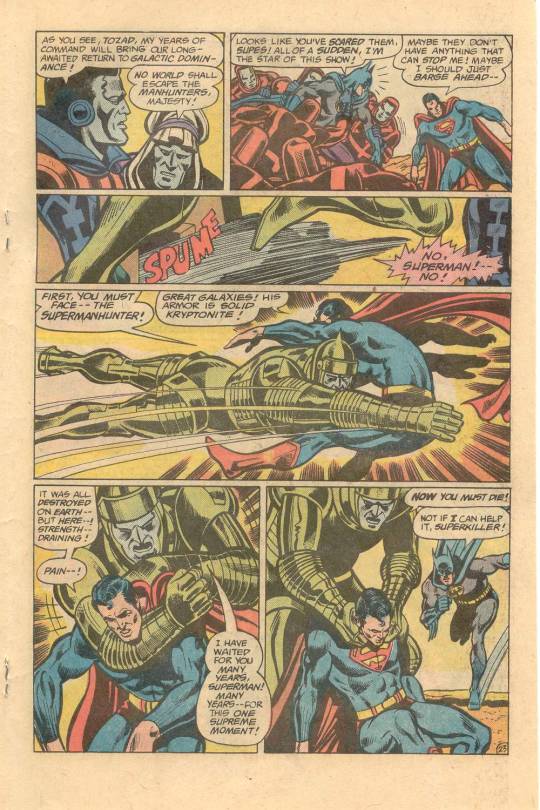
Back on Orinda, Superman and batman fight their way towards the mechanism that keeps the planet cloaked–once it’s disabled, the Manhunter’s ruse will be apparent for all to see. Unfortunately for them, the Manhunters have a Supermanhunter in reserve, one whose armor is made of solid Kryptonite. Despite being battered bloody, Superman tells Batman not to come to his aid, but rather to complete their mission. On Earth, Wonder Woman and Flash attempt to come to the aid of Green Lantern, Green Arrow and Black Canary, but they’er all beaten by the Manhunters.

Better news is taking place off in space, though, where batman has been able to battle his way to the Illusiotron keeping Orinda cloaked and turn it off. Even better for the Leaguers on Earth, they weren’t beaten by the Manhunters but rather took their places, switching costumes with them so that they could infiltrate undetected. And poor Mark Shaw is horrified to learn that what the League has been telling him about the Manhunters’ duplicity is true, and he destroys the Grandmaster in hand-to-hand combat, who turns out to have been one of the original androids all along. Shaw vows to make use of his Manhunter training to redeem himself. And only one question is left remaining: when the emergency signal went out, the Atom, Aquaman and the Elongated Man didn’t respond in any way. So where are they?

And once again, the issue closed with the 100 Issues Ago feature, this time spotlighting the first appearance of the League’s recurring enemy, the Key from JLA #41 in 1965. I loved this feature, almost more than the comic itself.
Post link
Here’s another good one, my subscription copy of JUSTICE LEAGUE OF AMERICA #140–so good that my brother Ken bought a second copy for himself, as he did from time to time. This was the first issue of JLA to completely fill the oversized format with a single story, an approach that would last for the next couple of years. This was really only possible thanks to the speed of JLA artist Dick Dillin. Dillin is one of those long-working craftsmen whose work is often overlooked–and for sure, it could become clunky at times, or overcrowded when he was juggling so many super heroes. But he was swift enough to be able to produce a full double-sized book every month, something that was a rarity even in 1976

Writer Steve Englehart had come over from Marvel the issue before, bringing a Marvel sense of characterization to his JLA stories which would continue to develop over the coming issues. To that, with this issue, he added a Marvel sense of continuity–this entire storyline turns upon taking a failed Jack Kirby launch for a new iteration of Manhunter and tying it into the origins on the Green Lantern Corps. It was an effective trick, of a kind that didn’t typically get showcased at DC, where continuity was still an iffy proposition.

The story opens at Bruce Wayne’s midtown penthouse, where Green lantern, Black Canary and Green Arrow happen to be, and where they’re attacked by the aforementioned Manhunter. GA and BC are quickly subdued, and GL gives himself up–and even the appearance of the Batman (who has, no kidding, been standing on the roof all the while this fight was happening) can stop him from making off with the hard-traveling heroes. Manhunter does confirm for Batman that he is related tot he Archie Goodwin/Walt Simonson Manhunter as well, another continuity piece looped together. Superman and Wonder Woman arrive in time for Superman to grab a piece of Manhunter’s teleporting craft, and the Flash is summoned to track its particular vibrational pattern.

Flash is able to track Manhunter’s teleportation to Nepal, which is where the story transitions to next, as Manhunter reveals himself as fallible former prosecutor Mark Shaw before the order’s Grandmaster–no Manhunter up until this time has ever left a trace, so in revealing their existence to the Justice League, he has failed their order. The groggy Green Arrow and Black Canary make a break for freedom but are foiled–and Green Lantern doesn’t help out at all. In fact, his Power Ring is uncharged, and when the Manhunters accuse him of a cosmic crime, his is strangely silent.

Following the trail to Nepal, Superman, Batman, Wonder Woman and Flash are ambushed by the Grandmaster, and imprisoned in a shrinking energy box that even Superman cannot break free of. But in typical JLA style, Superman and Flash combine their speed powers, accelerating Flash past his previous limits of vibrating such that he can slip between the molecules of the deadly cube and then secure their escape. The Grandmaster reveals to the liberated JLA that the order of the Manhunters are agents of justice, bounty hunters who for centuries have plied their trade across the cosmos. And now they have come for Green Lantern, for the gravest crime of all.

And so it’s time for Green Lantern to reveal his crime–a crime for which he intends to resign from the Justice League and give up his badge as Green Lantern. For the previous day, in attempting to protect a planet in his space-sector from a meteor shower, something went terribly wrong, and instead the Lantern’s power-beam was reflected off the target moon and had destroyed the planet Orinda itself and all life upon it. The JLA is skeptical of this account, and the Grandmaster gives them some time to collect evidence of Hal Jordan’s guilt or innocence–but not very much time.

Leaving Green Arrow and Black Canary behind with Green Lantern as hostages, the JLA journeys out into space to the moon of Orinda looking for answers. There, they find a member of the Guardians of the Universe under attack by an angry mob–the Guardians created and oversee the Green lantern Corps, and so the populace of the moon of Orinda blame him for the planet’s destruction. The JLA comes to his rescue, and then the group briefly powwows with Governor Tozad of the moon colony, who reveals to them that the Manhunters are known at the highest levels of government across the galaxy. Together, the group heads out to check out the desert area of the moon, where Green lantern’s power-beam would have struck.

Back on Earth, Green Arrow trades barbs with Manhunter Mark Shaw, until another Guardian appears in the room. This new arrival blasts Shaw into unconsciousness, frees the three JLA members and insists that Green Lantern recharge his Power Ring with the power battery he has brought with him. Despite GL’s protestations, the Guardian insists that more is going on here than GL realizes, and that the trio must escape the Manhunters and avoid their pursuit. Reluctantly, the guilt-stricken Green Lantern blasts his teammates to safety.

Back on the devastated moon of Orinda, the Leaguers find themselves attacked by a mythological creature, a Magnosaurus, and the powers of Superman, Wonder Woman and the Flash prove useless against it. It’s Batman who figures out the game–the Magnosaur isn’t real, it’s just an illusion. What’s more, the fact that the Moon is still in a stable orbit indicates that Orinda must still exist and just be cloaked from view. But who or what could cause that?

It’s the Guardian who provides the answer, by revealing that Governor Tozad himself is one of the Manhunters, whose aim, it seems, is to discredit the Guardians and the Green Lantern Corps. And now that their secret is out in the open, it means open warfare between the Cult of the Manhunter and the Justice League of America. And that’s where this installment ends, in a To Be Continued!

But that wasn’t quite the end of the issue, as after the letters page came the inaugural edition of a new regular feature, showcasing what was going on 100 issues earlier in JUSTICE LEAGUE OF AMERICA. Because I was hugely interested in the history and earlier stories of these characters, this feature was my meat–and this short two-page recap of JLA #40 from ten years previous was simultaneously intriguing and imagination-spurring. I loved these two pages almost more than the rest of the issue, to be honest.
Post link

Avengers #105 (Englehart/Buscema, Nov 1972). Seeking Pietro in the Savage Land, the Vision realizes he — unlike his fellow male Avengers — is unaffected by the siren Lorelei. He concludes that he must be incapable of love. I think he’s just such a Wife Guy (Wife Bot?) that seductresses have no affect on him.

Defenders #1 (Englehart/Buscema, Aug 1972). Hulk keeps cool long enough to ask Dr Strange for help rescuing Namor from a necromancer. This team doesn’t make any sense but I’m kinda into that dynamic.

Captain America and the Falcon #156 (Englehart/Buscema, Dec 1972). Steve wonders if, without oversight, he could become the same bigoted nationalist. Sam and Sharon insist on being his teammates, and Steve still wanders away from them to “be alone.” I’ve gotta say, Englehart’s brought a sharper political and psychological perspective so far. Every time I start getting exhausted with a book, a new creator steps in and spruces things up.

Captain America and the Falcon #155 (Englehart/Buscema, Nov 1972). The imposter Cap turns out to be “the Captain America of the 1950s.” It’s neat, ‘cause the MCU has been assimilating the “off-brand” Marvel movies and TV shows into their narrative — and the comics were doing the same thing. This issue even goes so far as to reproduce panels from those 1950s comics. It all becomes canon, it all matters.

Captain America and the Falcon #154 (Englehart/Buscema, Oct 1972). The residents of Harlem and the Avengers rise up to support the Falcon’s fight with the imposter Cap.

Captain America and the Falcon #153 (Englehart/Buscema, Sept 1972). Val’s plan to make Fury jealous works alarmingly well, pitting SHIELD’s ramrod and the First Avenger in a pointless brawl. Finally Val clears everything up, Sharon quits SHIELD, she and Steve go on vacation, and Sam discovers a Cap imposter harassing Harlem. New writer, new status quo.

Defenders #3 (Englehart/Buscema, Dec 1972). The Silver Surfer’s been trapped on Earth for years now, but Doctor Strange thinks a quick detour through the Multiverse can free him. It’s a disastrous, maddening mission. Englehart brings some psychedelic storytelling, but Sal Buscema’s art is way too straightforward for such a trippy tale.

Avengers #106 (Englehart/Buckler & Tuska, Dec 1972). While the Vision broods over his inability to love, Steve receives visions of missions with Rick which never happened. The remaining Avengers seek Pietro, but discover instead a long-forgotten foe.

Defenders #2 (Englehart/Buscema, Oct 1972). Strange, Namor, and Hulk embark on an expedition to find the Silver Surfer.

Avengers #110 (Englehart/Heck, Mar 1973). I’ve been trying to read in six-issue chunks, but it’s getting tricky ‘cause everything’s so intertextual now! Quicksilver’s whereabouts were revealed last month in Fantastic Four, so now I’m ahead of that book. Hawkeye wanders into an issue of Daredevil. And Magneto emerges from the Savage Land to overwhelm the bookless X-Men. Phew! This world’s just not gonna stop expanding now, and I have to accept there’s no correct and fully coherent way to track it.

Avengers #109 (Englehart/Heck, Mar 1973). With Vision and Wanda finally making things official, jealous Clint puts his old purple suit back on and strikes out on his own. Kinda startling to watch him leave — he’s one of the most tenured Avengers now!

Avengers #108 (Englehart/Heck & et al, Feb 1973). The Vision and Captain America concoct a convoluted plan to defeat the Space Phantom and the Grim Reaper. There’s been an almost delirious amount of retconning lately, and it’s an interesting device for the moment — discovering new plots and relationships between the panel margins…

Avengers #107 (Englehart/Starlin & et al, Jan 1973). The Space Phantom and the Grim Reaper conspire to transplant the Vision’s synthezoid brain into Captain America’s body. I truly doubt Vision’s really gonna go through with it, but the suggestion that his lovesick misery might conceivably drive him to it is pretty neat.

Amazing Adventures #16 (Englehart/Brown, Jan 1973). The Juggernaut emerges from his enchanted prison and crashes a party attended by the Beast… and Marvel’s bullpen. I didn’t mind when Stan and Jack inserted themselves as characters into Fantastic Four. They had a relationship with Reed, it helped build the world out, and it was funny. Seeing the next generation of writers at this party struck me as smug and self-congratulatory.

Do you realize what you’ve done?!?


